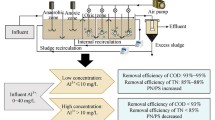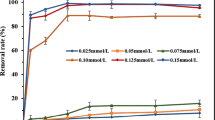Abstract
This study was undertaken to investigate the changes in flocculation properties of Fe-rich smectite (nontronite, NAu-1) suspensions, including settling velocity, aggregate size and floc architecture associated with microbial Fe(III)-reduction in the smectite structure. The dissimilatory Fe-reducing bacterium Shewanella oneidensis MR-1 was incubated with lactate as the electron donor and structural Fe(III) as the sole electron acceptor for 3, 12, 24 and 48 h in an anaerobic chamber. Two controls were prepared; the first was identical to the experimental treatments except that heat-killed cells were used (non-reduced control), and the second control was the same as the first except that the incubation was carried out in an aerobic environment. The extent of Fe(III) reduction for the 48 h incubation was observed to reach up to 18%. Neither the non-reduced control nor the aerobically inoculated sample showed Fe(III) reduction. Compared with the non-reduced control, there was a 2.7 μm increase in mean aggregate size and a 30-fold increase in average settling velocity in the bioreduced smectite suspensions as measured using a Micromeritics Sedigraph®. The aerobically inoculated smectite showed a similar aggregate-size distribution to that of the non-reduced control. Significant changes in physical properties of smectite suspensions induced by microbial Fe(III) reduction were measured directly using transmission electron microscopy. The floc architecture of bioreduced smectite revealed less open structures compared to those of a non-reduced control. The aspect ratio (thickness/length) of individual smectite particle increased from 0.11 for the non-reduced control to 0.18 on average for the bioreduced smectite suspensions. The effects of pH on the clay flocculation were minimal in this study because the value of pH remained nearly constant at pH = 7.0–7.3 before and after the experiments. We therefore suggest that the increase in net negative charge caused by microbial Fe(III) reduction significantly promoted clay flocculation by increasing the electrochemical attraction in the smectite suspensions.
Similar content being viewed by others
References
Ahn, J.H. and Peacor, D.R. (1986) Transmission and analytical electron microscopy of the smectite-to-illite transition. Clays and Clay Minerals, 34, 165–179.
Allison, M.A., Kineke, G.C., Gordon, E.S. and Goni, M.A. (2000) Development and reworking of a seasonal flood deposit on the inner continental shelf off the Atchafalaya River. Continental Shelf Research, 20, 2267–2294.
Brassard, P. and Fish, S. (2000) The effect of divalent metals and laminar shear on the formation of large freshwater aggregates. Hydrobiologia, 438, 143–155.
Chenu, C. and Guerif, J. (1991) Division s-6 sol and water management and conservation — mechanical strength of clay minerals as influenced by an adsorbed polysaccharide. Soil Science Society of America Journal, 55, 1076–1080.
Decho, A.W. (1990) Microbial exopolymer secretions in ocean environments — their role(s) in food webs and marine processes. Oceanography and Marine Biology, 28, 73–153.
Dong, H. (2002) Significance of electrophoretic mobility distribution to bacterial transport in granular porous media. Journal of Microbiological Methods, 50, 83–93.
Dong, H., Kukkadapu, R.K., Fredrickson, J.K., Zachara, J.M, Kennedy, D.W. and Kostandarithes, H.M. (2003) Microbial reduction of structural Fe(III) in illite and goethite by a groundwater bacterium. Environmental Science and Technology, 37, 1268–1276.
Droppo, I.G., Irvine, K.N. and Jaskot, C. (2002) Flocculation/ aggregation of cohesive sediments in the urban continuum: Implications for stormwater management. Environmental Technology, 23, 27–41.
Eisma, D., Boon, J., Groenewegen, R., Ittekkot, V., Kalf, J. and Mook, W.G. (1983) Observations on macro-aggregates, particle size and organic composition of suspended matter in the Ems Estuary. Mitteilungen Geologisch Palaontolgische Institut der Universität Hamburg. SCOPE/ UNEP Sonderband, 55, 295–314.
Gates, W.P., Wilkinson, H.T. and Stucki, J.W. (1993) Swelling properties of microbially reduced ferruginous smectite. Clays and Clay Minerals, 41, 360–364.
Gates, W.P., Jaunet, A.M., Tessier, D., Cole, M.A., Wilkinson, H.T. and Stucki, J.W. (1998) Swelling and texture of iron-bearing smectites reduced by bacteria. Clays and Clay Minerals, 46, 487–497.
Hill, P.S. (1996) Sectional and discrete representations of floc breakage in agitated suspensions. Deep Sea Research I, 43, 679–702.
Hill, P.S., Voulgaris, G. and Trowbridge, J.H. (2001) Controls on floc size in a continental shelf bottom boundary layer. Journal of Geophysical Research — Oceans, 106, 9543–9549.
Keeling, J.L., Raven, M.D. and Gates, W.P. (2000) Geology and characterization of two hydrothermal nontronites from weathered metamorphic rocks at the Uley graphite mine, South Australia. Clays and Clay Minerals, 48, 537–548.
Keller, M.D., Bellows, W.K. and Guillard, R.L. (1988) Microwave treatment for sterilization of phytoplankton culture media. Journal of Experimental Marine Biology and Ecology, 117, 279–283.
Kim, J.W. and Peacor, D.R. (2002) Crystal-size distributions of clays during episodic diagenesis: The Salton Sea geothermal system. Clays and Clay Minerals, 50, 371–380.
Kim, J.W., Peacor, D.R., Tessier, D. and Elsass, F. (1995) A technique for maintaining texture and permanent expansion of smectite interlayers for TEM observations. Clays and Clay Minerals, 43, 51–57.
Kim, J.W., Furukawa, Y., Daulton, T., Lavoie, D. and Newell, S. (2003) Characterization of microbially Fe(III)-reduced nontronite: environmental cell-transmission electron microscopy study. Clays and Clay Minerals, 51, 382–389.
Kim, J.W., Dong, H., Seabaugh, J., Newell, S. and Eberl, D. (2004) Role of microbes in the smectite-to-illite reaction. Science, 303, 830–832.
Kostka, J.E., Dalton, D., Skelton, H., Dollhopf, S. and Stucki, J.W. (2002) Growth of iron (III)-reducing bacteria on clay minerals as the sole electron acceptor and a growth yield comparison on a variety of oxidized iron forms. Applied and Environmental Microbiology, 68, 6256–6262.
Kostka, J.E., Stucki, J.W., Nealson, K.H. and Wu, J. (1996) Vol. 53, No. 6, 2005 Bacteria and smectite flocculation 579 Reduction of structural Fe(III) in smectite by a pure culture of Shewanella Putrefaciens strain MR-1. Clays and Clay Minerals, 44, 522–529.
Kostka, J.E., Wu, L., Nealson, K.H. and Stucki, J.W. (1999) The impact of structural Fe(III) reduction by bacteria on the surface chemistry of smectite clay minerals. Geochimica et Cosmochimica Acta, 63, 3705–3731.
Kranck, K. and Milligan, T.G. (1992) Characteristics of suspended particles at an 11-hour anchor station in San Francisco Bay, California. Journal of Geophysical Research, 97, 11373–11382.
Leppard, G.G., Heissenberger, A. and Herndl, G.J. (1996) Ultrastructure of marine snow. I. Transmission electron microscopy methodology. Marine Ecology Progress Series, 135, 289–298.
Manning, A.J. and Dyer, K.R. (1999) A laboratory examination of floc characteristics with regard to turbulent shearing. Marine Geology, 160, 147–170.
McCave, I.N. (1975) Verticla flux of particles in the ocean. Deep Sea Research Oceanography (Abstract), 22, 491–502.
Myers, C.R. and Nealson K.H. (1988) Bacterial manganese reduction and growth with manganese oxide as the sole electron acceptor. Science, 240, 1319–1321.
Orton, P.M. and Kineke, G.C. (2001) Comparing calculated and observed vertical suspended-sediment distributions from a Hudson River Estuary turbidity maximum. Estuarine Coastal and Shelf Science, 52, 401–410.
Stucki, J.W., Komadel, P. and Wilkinson, H.T. (1987) Microbial reduction of structural iron(III) in smectites. Soil Science Society of America Journal, 51, 1663–1665.
Theilen, F.R. and Pecher, I.A. (1991) Assessment of shear strength of the sea bottom from shear wave velocity measurements on box cores and in-situ. Pp. 67–74 in: Shear Wave in Marine Sediments (J.M. Hoven et al., editors). Kluwer Academic Publishers, The Netherlands.
Tolhurst, T.J., Gust, G. and Paterson, D.M. (2002) The influence of an extracellular polymeric substance (EPS) on cohesive sediment stability. Pp. 409–425 in: Fine Sediment Dynamics in the Marine Environment (J.C. Winterwerp and C. Kranenburg, editors). Elsevier, Amsterdam.
Tombacz, E., Csanaky, C. and Illes, E. (2001) Polydisperse fractal aggregate formation in clay mineral and iron oxide suspensions, pH and ionic strength dependence. Colloid and Polymer Science., 279, 484–492.
Traykovski, P., Geyer, W.R., Irish, J.D. and Lynch, J.F. (2000) The role of wave-induced density-driven fluid mud flows for cross-shelf transport on the Eel River continental shelf. Continental Shelf Research, 20, 2113–2140.
Wu, J., Roth, C.B. and Low, P.F. (1988) Biological reduction of structural iron in Na-nontronite. Soil Science Society of America Journal, 52, 295–296.
Author information
Authors and Affiliations
Corresponding author
Rights and permissions
About this article
Cite this article
Kim, JW., Furukawa, Y., Dong, H. et al. The Effect of Microbial Fe(III) Reduction on Smectite Flocculation. Clays Clay Miner. 53, 572–579 (2005). https://doi.org/10.1346/CCMN.2005.0530603
Received:
Revised:
Published:
Issue Date:
DOI: https://doi.org/10.1346/CCMN.2005.0530603




